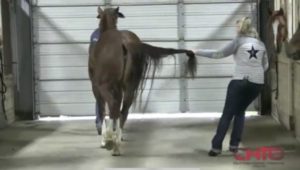
Dr. Molly Bellefeuille of Northern Star
Equine Speaking with CHTO’s Duncan
Steele-Park.
Ever had a horse that looked strangely unbalanced, had an abnormal gait or a lameness that you couldn’t put your finger on? It’s possible that horse is suffering from Equine Protozoal Myeloencephalitis or better known as EPM.
It’s a disease that’s probably more common than you may think. Most horses have antibodies but no clinical signs, hence are immune, but many don’t and diagnosing EPM can be challenging because it presents differently in every horse.
EPM is “a bug, or we can think of it like a worm that gets into the horse and causes neurologic damage. It is prevalent in the equine industry but it’s very regionally specific. Down here in Texas yes, we have a lot of it,” said Dr. Molly Bellefeuille.
EPM is carried by opossums and spread to the horse via feces. In places like Texas, there are lots of opossums, and they like to make nests in the hay sources so the hay is often contaminated with opossum feces.
While there is no vaccine for EPM, the disease is treatable. However it affects and damages the nervous system if treatment is administered too late.
“Nerves are not very good at regenerating. Think of people who become paralyzed, you can’t regenerate or fix that nerve damage. The same can be true with a horse if you don’t jump on top of it and get rid of that EPM, it can go through their system and affect their nerves. And that nerve damage can be long term depending upon the degree at which it’s affected,” said Dr Bellefeuille.
Because symptoms vary greatly and can be subtle, it’s important to contact your vet. But there are some things you can be on the lookout for.
“There are two main things we look for when evaluating a horse for EPM.”
Does the horse know where its feet are? Is it aware of the front feet placement and hind feet placement? And how is its muscle tone?
Lab tests can confirm the disease. The first is a serum blood test.
“It’s not 100% but it’s not saying the horse’s clinical signs are EPM. It’s saying the horse has been exposed to EPM,” she said.
The more complete test is a central nervous test. This test is invasive and will involve collecting spinal fluid from the horse.
When evaluating a horse, move their haunches over both directions and look for the hind legs crossing over. If the horse steps on itself or can’t seem to cross over, it could be a sign of something going on. Also, watch how the horse stands when you are done moving them around. The horse should square up. If they are camped out or standing with their legs crossed, or very close together, that could mean something.
Dr. Bellefeuille said “[Move their haunches] both directions. With EPM typically one side is more affected than the other.”
The next thing to evaluate is the horse’s strength. You can do this by seeing how they react to the tail pull. Stand to the side of the horse as it’s walking and try to pull the horse off of its straight line. Typically one side is weaker than the other.

The tail pull to check for signs of EPM.
“Typically the first time you do that tail pull, most all of them will give to it and that’s just their response [since they are trained] they want to please. The second and third tail pull, they will start resisting it and pull back. If they don’t, it’s because they are unaware or they don’t have the strength to do that. So we are evaluating their ability to pull back to that tail pull…[while watching foot placement again] because pulling their tail will make them want to become wide based and try to get in a stance where they can’t get pulled over… With EPM they won’t know where their hind feet are so they will easily be pulled over.”
Look at the condition of the hair coat. If every horse in the barn has a slick and shiny coat and the one horse has a dull coat it could be a sign of the disease. Dr. Bellefeuille also looks at muscle mass and assesses the top line and hip. Sometimes the muscles will have atrophied. EPM can cause behavioral issues as well. It can affect their optic nerve, which can make them see shadows or not be able to see normally. They can become lazy, weak and lethargic or the opposite where they are frightful, crazy and excitable. It just depends on what nerves the EPM is damaging.
There is one FDA approved medication used to treat EPM known by the brand name Marquis. The drug in it is called diclazuril. Dr. Bellefeuille said it’s safe for all horses. And a lot of people will just treat the horse without testing, but that comes down to the region she said. Some people treat all of their horses once a year and that comes down to budget.
There are a lot of compounded medications that can help that usually have Vitamin E in them.
“The Vitamin E really helps the recovery of the nervous system,” Dr. Bellefeuille said.
“If the EPM is really bad, it gets worse before it gets better. Because again it’s like a worm or bug moving around in there and if you kill it all off then you have a lot of that just floating around in their spinal column. Oftentimes in the first 5-10 days they can show signs that are worse clinically…We often recommend giving them a week or two off until those meds kick in. Once you have that kill off they rebound in about 2 weeks… Some of the nerve damage is there forever. Some of it we can’t repair.”
It’s not always a one and done treatment with EPM.
“It just depends on how bad the infestation is. Doing the blood test and CNS test and treating horses with it and then retesting them, in my opinion, is important as it actually takes awhile for that EPM to be fully killed off.”
There are a lot of places in the body the parasite can hide so sometimes a 30 day treatment isn’t enough. Sometimes it takes a while for the nerve damage to repair as well.
“When you’re paralyzed, you don’t, in 30 days, recover from that. It takes a lot of physical therapy and things to help regain nerve function back.”
Dr. Bellefeuille said fortunately pregnant mares don’t pass the disease to their foals in utero. To help combat EPM, set possum traps around the barn to help prevent the disease being spread. If you suspect your horse has EPM, make sure to consult your veterinarian.
